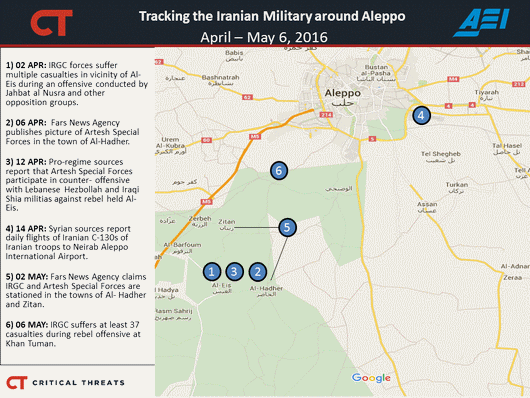{{currentView.title}}
May 12, 2016
What the Khan Tuman defeat means for Iran
The Islamic Revolutionary Guards Corps (IRGC) has suffered its first significant setback in the Aleppo campaign. Al Qaeda affiliate Jabhat al Nusra and allied groups in the Jaish al Fatah coalition overran Iranian positions in the town of Khan Tuman south of Aleppo city on May 6, leading to scores of casualties among IRGC troops and proxy militia forces.[1] This development could cause an intensification of Iranian military involvement to avenge the losses even as the U.S. presses Russia to resume the rapidly collapsing “cessation of hostilities.”
The Guards suffered at least 37 casualties in the fight, ranking it among the bloodiest days for Tehran in Syria’s civil war. The IRGC Karbala Division based in Mazandaran province suffered the heaviest losses with nearly 13 killed and 21 wounded.[2] A soldier from Tehran’s provincial IRGC unit, an IRGC Quds Force commander, and a retired IRGC brigadier general were also among the dead.[3] Fighters from the Afghan Shia Fatimiyoun Brigade, Lebanese Hezbollah, and Harakat Hezbollah al-Nujaba are estimated to have suffered around 50 deaths.[4] At least five Iranians were captured by rebel forces, along with an unspecified number of fighters from Iranian proxy groups. [5]
The scale of Tehran’s losses is surprising, but the composition of those forces is not. The casualty rolls support the Critical Threats Project’s previous assessment that the IRGC is deploying elements from its conventional units to serve as an integrating force among Iran’s diverse set of proxies around Aleppo.[6] The IRGC 25th Karbala Division appears to have been serving in this role since at least the second week of April when a large rebel offensive killed soldiers from that unit south of Aleppo.[7] The other proxy forces probably served as frontline fighters integrated within the Iranian command structure, strengthening our hypothesis that the conventional IRGC troops serve as command cadre for foot soldiers drawn from among the militias on the battlefield.
Other IRGC units have suffered significant losses in Syria, although not at quite this level. The IRGC 2nd Imam Sajjad Brigade lost at least 10 soldiers within three days in February, for example.[8] The IRGC 2nd Imam Mojtaba Brigade lost at least six men during the operations that had culminated in the seizure of Khan Tuman from rebel forces in December.[9] Iranian officials could justify those losses as the price of victory on the battlefield, but the recent clashes are a very public defeat for Iran’s much-touted “Axis of Resistance” in Syria.
Iranian officials have predictably clamored to explain the defeat. IRGC Deputy Commander Hossein Salami blamed the loss on a “tactical change” by the rebels and maintained that Iranian and pro-regime forces are still “in full control of the situation.”[10] Salami’s assessment is probably correct in that opposition operations around Khan Tuman appear to be part of a significant counter-offensive, quite possibly timed to coincide with the major Russian media effort to bring reporters to its positions near Palmyra.[11] That effort required the diversion of Russian air assets, and the opposition may have planned the attack at Khan Tuman to take advantage of Russia’s distraction. Former IRGC Commander Mohsen Rezaei claimed more hyperbolically that the defeat was the result of U.S., Turkish, and Saudi generals embedding with the rebel groups, underscoring Tehran’s perception of the rebel offensive as an intensification in the regional proxy war.[12]
The strategic logic of Iran’s Syria mission will likely drive the IRGC toward greater escalation in response to this setback. Iran has incrementally ramped up its support for the Assad regime in order to fill capability gaps in the past, and there is no indication that Tehran will dial back support now.[13] The Guard will want to avenge this defeat, moreover, and re-establish its credibility in the fight around Aleppo, which remains a strategically important prize for the Assad regime. Iranian military officials have vowed to retake Khan Tuman and Iranian news outlets have published pictures of Iranian-backed forces massing for fresh counter-attacks on the town.[14] At least one IRGC soldier has already been reported killed in fresh fighting around Khan Tuman. [15]
The impact of this defeat on the strength of the Iranian-Russian-Syrian coalition in Syria is less clear. The heavy Russian air-cover that enabled Iranian advances around Aleppo in recent months noticeably did not come to the aid of the Iranian troops at Khan Tuman, possibly because of the Palmyra photo-op, or because Moscow prefers to maintain the fiction of a reduction in fighting around Aleppo to facilitate continued negotiations with the U.S. More than one Iranian reporter has criticized the Russians for being “indifferent” about the plight of Iranians at Khan Tuman, although regime officials have taken a much more neutral tone.[16] The coming weeks will be a crucial indicator for the health of the Tehran-Moscow alliance as Iranian backed forces ramp up for a probable offensive south of Aleppo. They will also reveal how much effort Iran is willing to put into the Syrian war and how much it is prepared to lose on behalf of the Assad regime.
- 02 APR: “Iran News Round Up, April 4, 2016,” AEI’s Critical Threats Project, April 4, 2016. Available: http://www.irantracker.org/iran-news-round-april-04-2016
- 06 APR: Fars News International. Twitter Post. April 6, 2016, 1:27 AM. Available: https://twitter.com/FarsNewsInt/status/717629894147092480
- 12 APR: “Hezbollah assault on Al-Eis in southern Aleppo repelled by Jabhat al-Nusra,”Al Masdar News, April 12, 2016. Available: https://www.almasdarnews.com/article/hezbollah-assault-al-eis-southern-aleppo-repelled-jabhat-al-nusra/
- 14 APR: “Source: 12 Iranian aircraft landed at Aleppo International Aircraft in a week,” Zaman al Wasl, April 14, 2016. Available: https://www.zamanalwsl.net/news/70218.html
- 02 MAY: “Iran News Round Up, May 2, 2016,” AEI’s Critical Threats Project, May 2, 2016. Available: http://www.irantracker.org/iran-news-round-may-2-2016
- 06 MAY: Paul Bucala, “What the Khan Tuman defeat means for Iran,” AEI’s Critical Threats Project, May 12, 2016. Available: http://www.irantracker.org/analysis/bucala-what-the-khan-tuman-defeat-means-for-iran-may-12-2016

